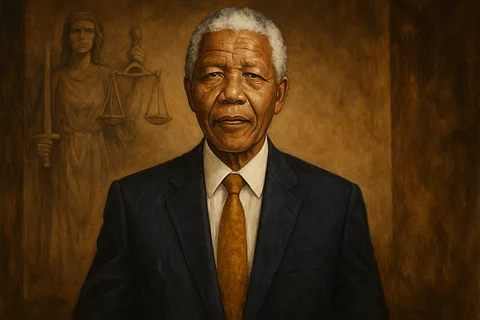
- Home
- न्यूजग्राम
- India
- World
- Politics
- Entertainment
- Culture
- Lifestyle
- Economy
- Sports
- Sp. Coverage
- Misc.
- NewsGram Exclusive
- Jobs / Internships

Nelson Mandela is one of the most respected figures in modern history — a true symbol of courage, justice, and peace. From his early life as a young boy named Rolihlahla in a small South African village to becoming the first Black president of a free and democratic South Africa, Mandela’s life was full of challenges, sacrifices, and inspiring achievements.
Driven by the belief that all people, regardless of race or background, deserve equal rights and opportunities, Mandela stood firm against hatred and injustice. Even in the face of oppression, he chose the path of peace, forgiveness, and unity. His leadership played a crucial role in dismantling apartheid — a harsh system of racial segregation — and his legacy continues to inspire generations across the globe.
Here are five important and fascinating facts about the legendary Nelson Mandela.
Mandela Earned Bachelor’s Degree During Life Imprisonment
Nelson Mandela went on to study at Fort Hare University, where he met Oliver Tambo. However, he was expelled for leading a student protest. While working, he completed his B.A. from University of South Africa (UNISA) and began studying law at the University of the Witwatersrand.
In 1964, he was sentenced to life in prison for opposing the apartheid system. He spent 18 of his 27 years in jail on Robben Island, near Cape Town. Later, he was moved to Pollsmoor Prison, a maximum-security jail. After being treated for tuberculosis in 1988, he was transferred to Victor Verster Prison near Paarl.
His prison number was 466/64, which meant he was the 466th prisoner in the year 1964. While in prison, Mandela continued his education and earned a law degree through the University of London’s correspondence program. He was released in 1990, ending one of the most powerful chapters in the fight against apartheid.
First Black Law Firm of South Africa
In 1953, Nelson Mandela and Oliver Tambo started South Africa’s first Black law firm, called Mandela & Tambo Attorneys. This was during a time when the apartheid laws were very unfair to non-white people in the country. Before them, a few Black lawyers like Alfred Mangena, Pixley ka Isaka Seme, and George Dixon Montsio had already become lawyers. But Mandela and Tambo’s firm was the first Black legal partnership in South Africa.
Their office became a safe place for Black South Africans who were suffering from discrimination, losing their land, and other injustices caused by apartheid. In his book Long Walk to Freedom, Mandela wrote that their office was always crowded with people. Sometimes, they had to push through the crowd just to get to their desks.
See Also:
As time passed, Mandela and Tambo became more involved in politics, and they could not continue working full-time as lawyers. But their law firm remained a strong symbol of justice and resistance during a very difficult time in South Africa’s history.
Mandela: Boxer and Guerrilla Fighter
Nelson Mandela loved sports, especially boxing and long-distance running. He trained as a heavyweight boxer and even sparred with top fighters. He trained seriously as an amateur heavyweight boxer and even practiced with professional fighters like Jerry Moloi, a top South African boxer. Mandela once said that he loved boxing because it was fair and equal — in the boxing ring, it didn’t matter who you were, what colour your skin was, or how rich you were. He said,
“Boxing is equal for everyone. In the ring, your rank, age, colour, or money doesn’t matter.”
Though Mandela didn’t fight much after he joined politics, he continued training because it helped him release stress and stay healthy. He kept doing early morning workouts even later in life.
Mandela believed sometimes using force was necessary to fight apartheid. In 1962, he received military training in Ethiopia. where he learned how to use weapons like rifles, pistols, bombs, and landmines. He also travelled to Algeria, which was then fighting a war to become free from French rule, and got guerrilla training (special fighting techniques used in wars of freedom).
But he never used them in battle. He was arrested shortly after returning to South Africa, in August 1962, before he could take part in any fighting.
Mandela was on the U.S. terrorist watch list until 2008.
In the 1980s, the U.S. government put Nelson Mandela and the African National Congress (ANC) on a terrorist watch list because the ANC was fighting against apartheid using armed resistance. Even after Mandela became a global hero and won the Nobel Peace Prize, he and other ANC members were still on that list.
But on 1 July 2008, U.S. President George W. Bush signed a law to officially remove Mandela and many ANC members from the list. This allowed them to travel freely to the U.S. and helped improve relations between the U.S. and South Africa. Many people, including U.S. senators, worked hard to fix what they saw as an unfair and embarrassing situation.
Mandela: The only Black figure in Parliament Square.
Nelson Mandela is the only Black president to have a statue in Parliament Square, London, a place known for statues of famous leaders like Winston Churchill and Abraham Lincoln. His 9-foot bronze statue, made by artist Ian Walters at a cost of £400,000 and unveiled on 29 August 2007, stands as a symbol of freedom and justice.
The statue honours Mandela’s role in ending apartheid and fighting for equality in South Africa. He once joked with his friend Oliver Tambo about the idea of a Black figure joining the leaders in Parliament Square — became a powerful reality. Mandela said the statue represents not just him, but all who stood against oppression. [Rh/VP]
